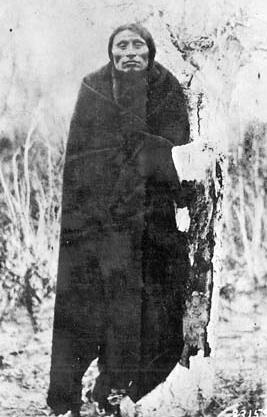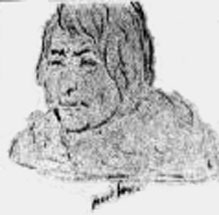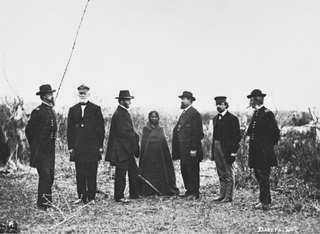Related Research Articles

The Crow, whose autonym is Apsáalooke, also spelled Absaroka, are Native Americans living primarily in southern Montana. Today, the Crow people have a federally recognized tribe, the Crow Tribe of Montana, with an Indian reservation, the Crow Indian Reservation, located in the south-central part of the state.

The Cheyenne are an Indigenous people of the Great Plains. The Cheyenne comprise two Native American tribes, the Só'taeo'o or Só'taétaneo'o and the Tsétsêhéstâhese ; the tribes merged in the early 19th century. Today, the Cheyenne people are split into two federally recognized nations: the Southern Cheyenne, who are enrolled in the Cheyenne and Arapaho Tribes in Oklahoma, and the Northern Cheyenne, who are enrolled in the Northern Cheyenne Tribe of the Northern Cheyenne Indian Reservation in Montana. The Cheyenne language belongs to the Algonquian language family.

Crow Agency is a census-designated place (CDP) in Big Horn County, Montana, United States and is near the actual location for the Little Bighorn National Monument and re-enactment produced by the Real Bird family known as Battle of the Little Bighorn Reenactment. The population was 1,616 at the 2010 census. It is the governmental headquarters of the Crow Native Americans. It is also the location of the "agency offices" where the federal Superintendent of the Crow Indian Reservation and his staff interacts with the Crow Tribe, pursuant to federal treaties and statutes.

Red Cloud was a leader of the Oglala Lakota from 1865 to 1909. He was one of the most capable Native American opponents whom the United States Army faced in the western territories. He led the Lakota to defeat the United States during Red Cloud's War, establishing the Lakota as the only nation to defeat the United States on American soil. The largest action of the war was the 1866 Fetterman Fight, with 81 US soldiers killed; it was the worst military defeat suffered by the US Army on the Great Plains until the Battle of the Little Bighorn 10 years later.

Red Cloud's War was an armed conflict between an alliance of the Lakota, Northern Cheyenne, and Northern Arapaho peoples against the United States and the Crow Nation that took place in the Wyoming and Montana territories from 1866 to 1868. The war was fought over control of the western Powder River Country in present north-central Wyoming.

The Treaty of Fort Laramie is an agreement between the United States and the Oglala, Miniconjou, and Brulé bands of Lakota people, Yanktonai Dakota, and Arapaho Nation, following the failure of the first Fort Laramie treaty, signed in 1851.

The Grattan Massacre, also known as the Grattan Fight, was the opening engagement of the First Sioux War, fought between the United States Army and Lakota Sioux warriors on August 19, 1854. It occurred east of Fort Laramie, Nebraska Territory, in present-day Goshen County, Wyoming.

Little Wolf was a Northern Só'taeo'o Chief and Sweet Medicine Chief of the Northern Cheyenne. He was known as a great military tactician and led a dramatic escape from confinement in Oklahoma back to the Northern Cheyenne homeland in 1878, known as the Northern Cheyenne Exodus.

The Sioux Wars were a series of conflicts between the United States and various subgroups of the Sioux people which occurred in the later half of the 19th century. The earliest conflict came in 1854 when a fight broke out at Fort Laramie in Wyoming, when Sioux warriors killed 31 American soldiers in the Grattan Massacre, and the final came in 1890 during the Ghost Dance War.

The Bozeman Trail was an overland route in the Western United States, connecting the gold rush territory of southern Montana to the Oregon Trail in eastern Wyoming. Its most important period was from 1863 to 1868. Despite the fact that the major part of the route in Wyoming used by all Bozeman Trail travelers in 1864 was pioneered by Allen Hurlbut, it was named after John Bozeman. Many miles of the Bozeman Trail in present Montana followed the tracks of Bridger Trail, opened by Jim Bridger in 1864.

The Fort Laramie Treaty of 1851 was signed on September 17, 1851 between United States treaty commissioners and representatives of the Cheyenne, Sioux, Arapaho, Crow, Assiniboine, Mandan, Hidatsa, and Arikara Nations. Also known as Horse Creek Treaty, the treaty set forth traditional territorial claims of the tribes.

Spotted Tail was a Sichangu Lakota tribal chief. Famed as a great warrior since his youth, warring on Ute, Pawnee and Absaroke (“Crow”), and having taken a leading part in the Grattan Massacre, he led his warriors in the Colorado and Platte River uprising after the massacre performed by John M. Chivington's Colorado Volunteers on the peaceful Cheyenne and Arapaho camping on Sand Creek, but declined to participate in Red Cloud's War.

Crazy Bear was a chief of the Assiniboine tribes of the northern plains. Their territory included Montana, North Dakota, Alberta and Saskatchewan. He is known as a skilled negotiator with the American Fur Company at Fort Union, North Dakota, and remembered for his participation and representation at the Fort Laramie Treaty Council of 1851—where he was a signatory of the treaty. He earned the name Mah-To-Wit-Ko because he fought like a crazy bear. Wit-Ko is a Siouan word that has multiple translations: crazy, foolish, frightening and mad. Crazy Bear has been recorded by these names and also in French as Ours Fou.

Hollow Horn Bear was a Brulé Lakota chief. He fought in many of the battles of the Sioux Wars, including the Battle of Little Big Horn.

Lone Horn, also called One Horn, born in present-day South Dakota, was chief of the Wakpokinyan band of the Minneconjou Lakota.
The Battle of Honsinger Bluff was a conflict between the United States Army and the Sioux people on August 4, 1873 along the Yellowstone River near present-day Miles City, Montana. This was U.S. territory acquired from the Crows in 1868. The main combatants were units of the U.S. 7th Cavalry under Lt. Col. George Armstrong Custer, and Native Americans from the village of the Hunkpapa medicine man, Sitting Bull, many of whom would clash with Custer again approximately three years later at the Battle of the Little Big Horn in the Crow Indian Reservation.

The Indian Peace Commission was a group formed by an act of Congress on July 20, 1867 "to establish peace with certain hostile Indian tribes." It was composed of four civilians and three, later four, military leaders. Throughout 1867 and 1868, they negotiated with a number of tribes, including the Comanche, Kiowa, Arapaho, Kiowa-Apache, Cheyenne, Lakota, Navajo, Snake, Sioux, and Bannock. The treaties that resulted were designed to move the tribes to reservations, to "civilize" and assimilate these native peoples, and transition their societies from a nomadic to an agricultural existence.

Pierre-Jean De Smet, SJ, also known as Pieter-Jan De Smet, was a Flemish Catholic priest and member of the Society of Jesus (Jesuits). He is known primarily for his widespread missionary work in the mid-19th century among the Native American peoples, in the midwestern and northwestern United States and western Canada.

Chief Big Robber, also known as Big Shadow or Big Robert, was a 19th century Crow chief. He was a participant in the Fort Laramie Treaty of 1851. His name Big Shadow referred to his large stature.

Friday (Arapaho: Teenokuhu or Warshinun, also known as Friday Fitzpatrick, was an Arapaho leader and interpreter in the mid to late 1800s. When he was around the age of eight, he was separated from his band and was taken in by a white trapper. During the next seven years, he was schooled in St. Louis, Missouri and went on trapping expeditions with his informally adopted father, Thomas Fitzpatrick. After he was recognized by his mother during an encounter with the Arapaho, he returned to the tribe.
References
- ↑ Robert C. Carricker: Father Peter John De Smet: Jesuit in the West (Oklahoma Western Biographies), p. 173; University of Oklahoma Press (1998) ISBN 0-8061-2790-2
- ↑ Bray, Kingsley M. (1985). "Lone Horn's Peace: A New View of Sioux-Crow Relations, 1851-1858" (PDF). Nebraska History. 66: 28–47. Archived from the original on December 18, 2010. Retrieved 13 September 2021.
{{cite journal}}: CS1 maint: unfit URL (link)